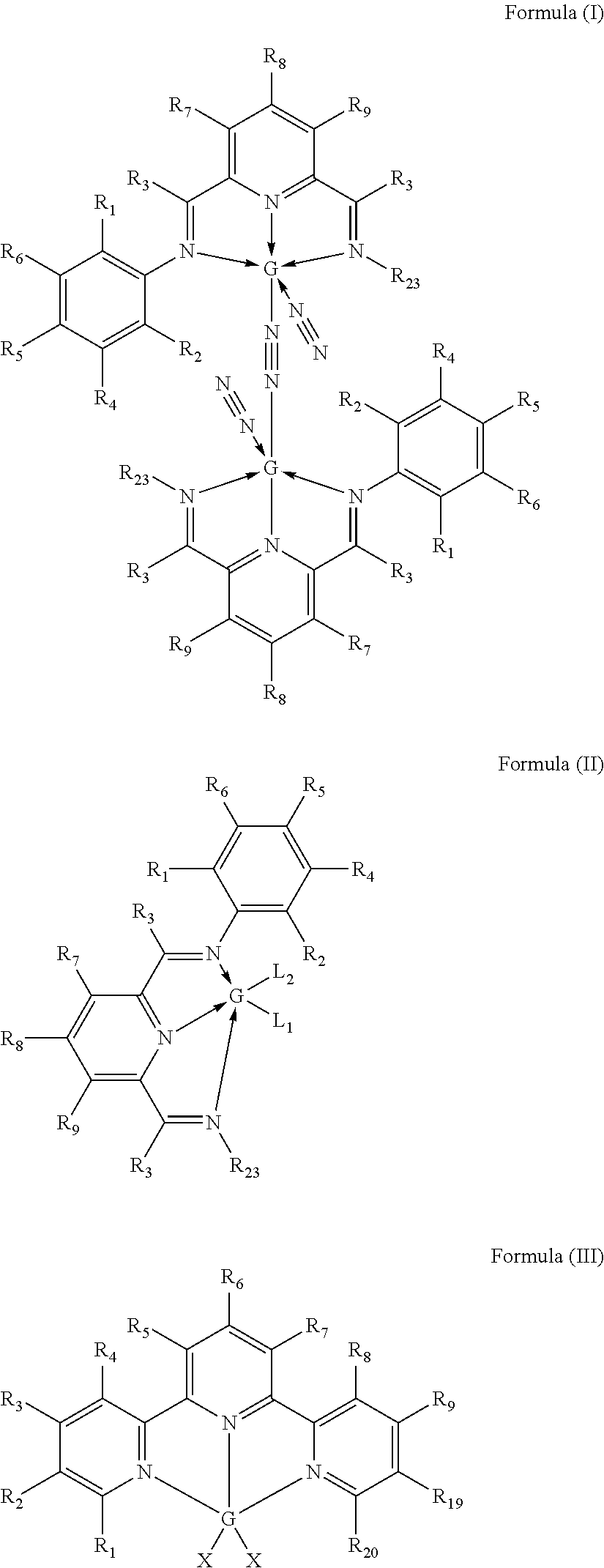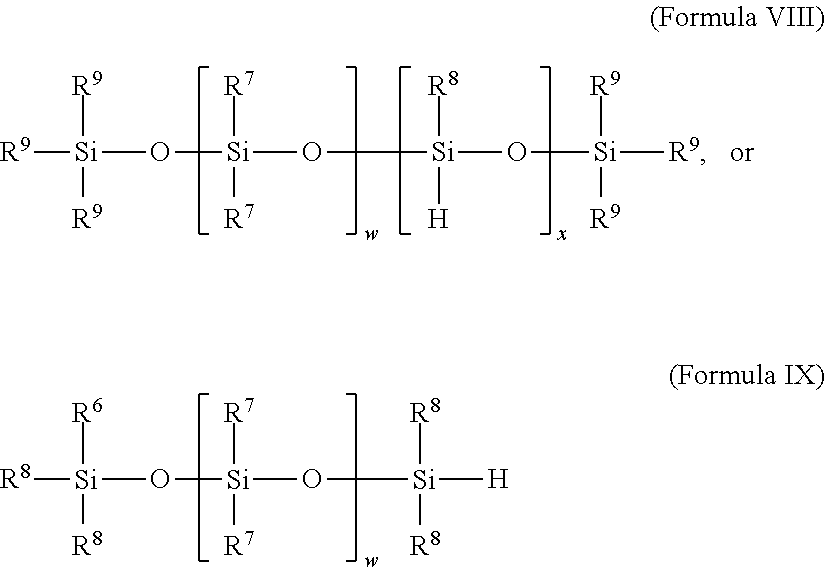Selective non-precious metal-catalyzed mono-hydrosilylation polyunsaturated compounds
a mono-hydrosilylation and non-precious metal technology, applied in the direction of organic compounds/hydrides/coordination complexes, physical/chemical process catalysts, iron organic compounds, etc., can solve the problem of less than desirable selection of conventional precious metal based catalysts towards mono-hydrosilylation
- Summary
- Abstract
- Description
- Claims
- Application Information
AI Technical Summary
Problems solved by technology
Method used
Image
Examples
example 1
Separation of Commercial Trivinyleyclohexane (TVCH)
[0095]This Example illustrates the separation of commercial trivinylcyclohexane (TVCH) into fractions corresponding to Isomers A, B, C and D, as defined hereinabove, and the characterization of the fractions by gas chromatography (GC) and NMR spectroscopy.
Distillation Apparatus
[0096]A batch distillation apparatus was set up to separate the TVCH isomers. The apparatus comprised a 5-liter flask as a boiler, which was fitted to a 50 mm diameter vacuum-jacketed distillation column filled with 316 stainless steel protruded metal packing (Propac; 0.16 inch size; H.S. Martin, Inc. item number 509100-0016) to a height of 1700 mm. The bottom of the column had a drip tip to permit the determination of the reflux return rate by visually monitoring the rate at which liquid dripped back into the boiler. The top of the column was fitted with an adjustable distillate takeoff head. Heat was supplied to the flask by an electric heating mantle (Glas ...
example 2
Selective Mono-Hydrosilylation of TVCH Isomer A by bis(Trimethylsiloxy)Methylsilane (MDHM)
[0101]The 1,2,4-trivinylcyclohexane sample used in this experiment was prepared as described in Example 1. It contained 98.4% Isomer A and 1.6% Isomer B. The experiment was conducted in an inert atmosphere.
[0102]A scintillation vial was charged with 1.0 g (6.16 mmol) 1,2,4-trivinylcyclohexane and 0.002 g (0.002 mmol) of [(2,6-Et2PDI)Fe(N2)]2[μ-(N2)] (0.03 mol % catalyst to silane). To the stirring solution was added 1.370 g (6.16 mmol) of MDHM dropwise over the course of 10 minutes at 23° C. The SiH / Vinyl molar ratio was (1:3). The reaction was stirred for 20 minutes and then quenched in air and analyzed by GC. The major GC peak was the mono-hydrosilylated product, which was 76.9% of the total mass. The bis-hydrosilylated product was 17.6%. Thus, the gravimetric ratio was 4.4.
[0103]Proton NMR showed that 90% of the mono-hydrosilylation product was the regioisomer in which silylation had occurre...
example 3
Mono-Hydrosilylation of TVCH Isomer A with Triethoxysilane (TES)
[0104]The 1,2,4-trivinylcyclohexane sample used in this experiment was prepared as described in Example 1. It contained 98.4% Isomer A and 1.6% Isomer B. TES was prepared by the Direct Process disclosed in U.S. Pat. No. 7,429,672.
[0105]In an inert atmosphere at 23° C., a scintillation vial was charged with 0.150 g (0.92 mmol) of 1,2,4-trivinylcyclohexane and 0.150 g (0.92 mmol) of TES. The SiH / Vinyl molar ratio was (1:3). To the stirring solution was added 0.002 g (0.002 mmol) of [(2,6-Et2PDI)Fe(N2)]2[μ-(N2)] (0.2 mol % catalyst to silane). An exotherm occurred. The reaction was stirred for about 60 minutes and then quenched in air. Analysis of the reaction mixture by GC and GC / MS provided evidence that TES was completely consumed and that the mono and bis-hydrosilylation products were present in 60.2% and 24.4%, respectively. The gravimetric ratio was 2.46.
[0106]Proton NMR analysis revealed that mono-hydrosilylation ha...
PUM
| Property | Measurement | Unit |
|---|---|---|
| temperature | aaaaa | aaaaa |
| temperature | aaaaa | aaaaa |
| temperature | aaaaa | aaaaa |
Abstract
Description
Claims
Application Information
 Login to View More
Login to View More - R&D
- Intellectual Property
- Life Sciences
- Materials
- Tech Scout
- Unparalleled Data Quality
- Higher Quality Content
- 60% Fewer Hallucinations
Browse by: Latest US Patents, China's latest patents, Technical Efficacy Thesaurus, Application Domain, Technology Topic, Popular Technical Reports.
© 2025 PatSnap. All rights reserved.Legal|Privacy policy|Modern Slavery Act Transparency Statement|Sitemap|About US| Contact US: help@patsnap.com



